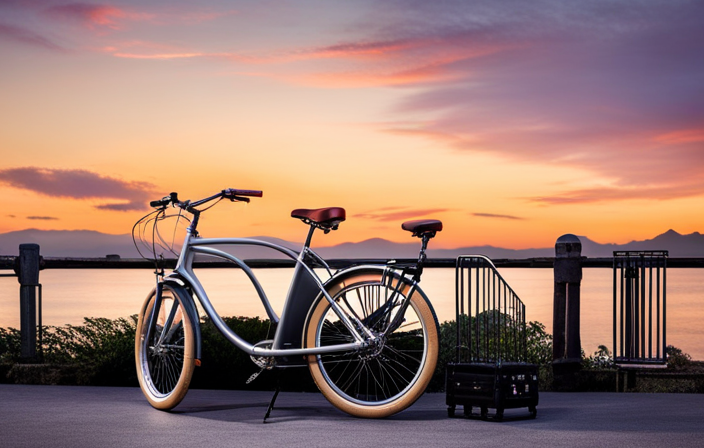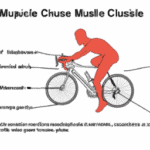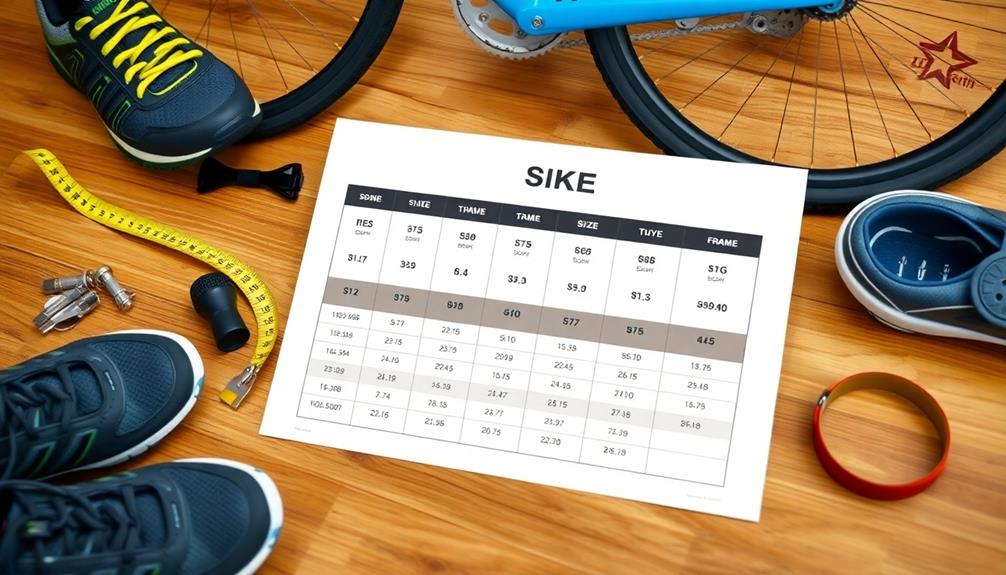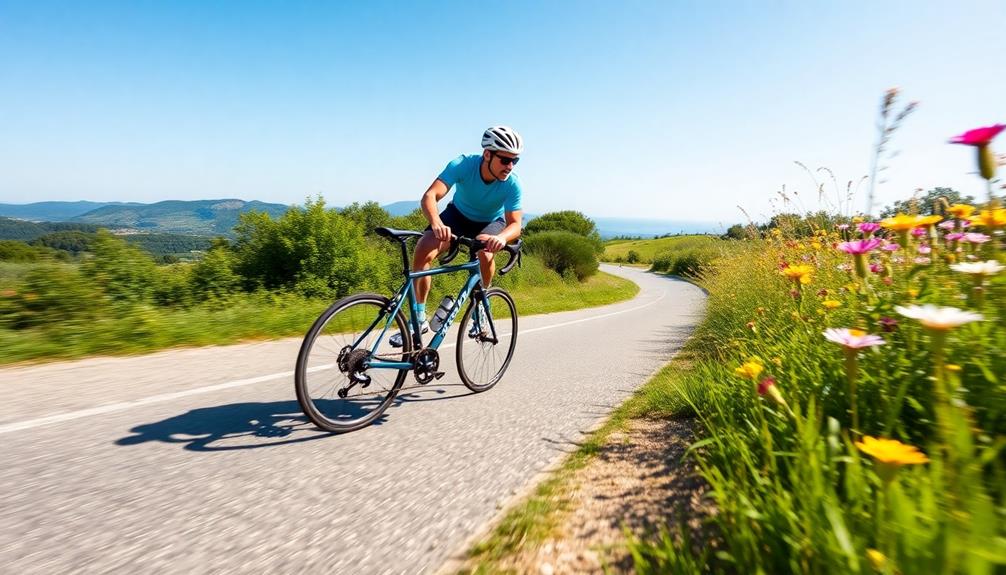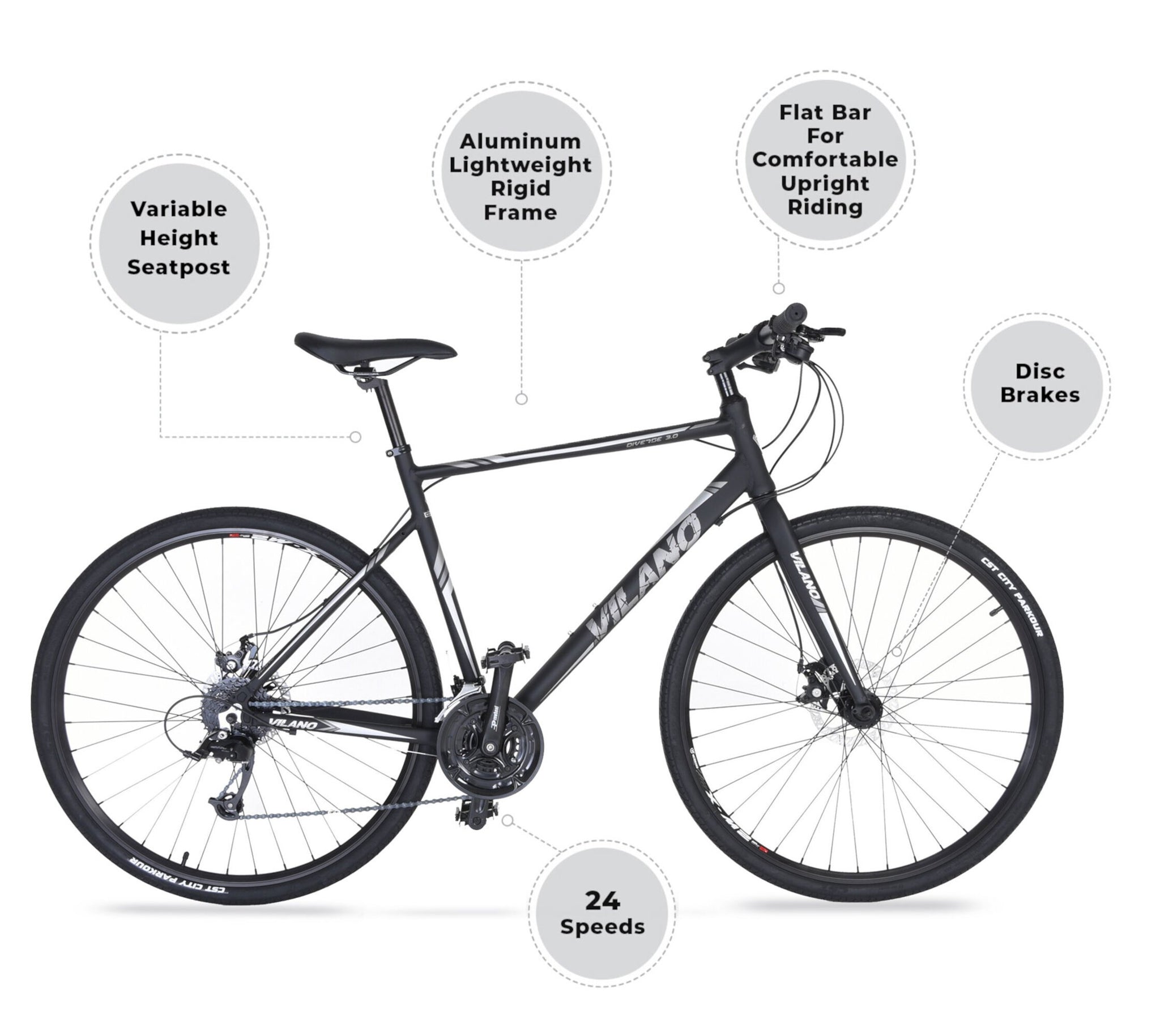
Are you ready to take on the challenge of long-distance hybrid bike rides? We know what you might be thinking – it seems like a daunting task. But fear not! We are here to guide you through the process and help you master this art.
From building physical strength to planning your nutrition, we have all the tips and tricks you need.
So, get ready to pedal your way to liberation and conquer those miles!
Key Takeaways
- Incorporate strength training exercises into your regular workout routine
- Gradually extend duration and distance of rides over time
- Fuel up with a balanced meal containing carbohydrates, protein, and healthy fats before the ride
- Include rest days to allow the body to recover and recharge
Building Physical Strength
We need to focus on building our physical strength to conquer long-distance hybrid bike rides. Building physical strength is crucial for injury prevention and enhancing our mental resilience during these challenging rides.

To build physical strength, we should incorporate strength training exercises into our regular workout routine. Exercises like squats, lunges, and deadlifts help strengthen our leg muscles, which are vital for powering through long rides. Additionally, core exercises such as planks and Russian twists improve stability and balance, reducing the risk of injuries caused by improper form or fatigue.
Incorporating cardiovascular exercises like cycling, running, or swimming into our training regimen will also contribute to building endurance and overall fitness. These exercises improve our cardiovascular system, allowing us to endure longer rides without feeling exhausted.
Remember to gradually increase the intensity and duration of our workouts to avoid overexertion and injuries. It’s important to listen to our bodies and take rest days to allow for proper recovery.
Increasing Biking Stamina
To increase our biking stamina, we should gradually extend the duration and distance of our rides over time. This allows our bodies to adapt to the increased physical demands of long-distance cycling. In addition to building physical strength, there are several cycling techniques and mental preparation strategies that can help us improve our endurance and enjoy our rides to the fullest.

Some techniques to increase biking stamina include:
- Interval training: Incorporate short bursts of high-intensity cycling followed by periods of rest to improve cardiovascular fitness and endurance.
- Hill training: Find challenging inclines to climb during your rides, which help build leg strength and improve overall stamina.
When it comes to mental preparation, consider:
- Visualization: Picture yourself conquering long rides and overcoming any obstacles that may come your way.
- Positive self-talk: Use affirmations and encouraging words to boost your confidence and motivation during rides.
Planning Your Nutrition
But let’s not forget about the importance of fueling our bodies properly during long-distance hybrid bike rides. Nutrition timing and fueling strategies play a crucial role in ensuring optimal performance and recovery.
Before setting off on your ride, it’s essential to fuel up with a balanced meal containing carbohydrates for energy, protein for muscle repair, and healthy fats for sustained energy.

During your ride, it’s important to consume easily digestible carbohydrates to replenish glycogen stores and electrolytes to maintain hydration. Snacks like energy gels, bars, or fruits can provide quick and convenient sources of fuel.
Don’t wait until you feel hungry or fatigued, as it may be too late to prevent energy depletion. Experiment with different fueling strategies during training rides to find what works best for you.
Prioritizing Hydration
How can we ensure that we prioritize hydration during long-distance hybrid bike rides? Hydration techniques and water intake strategies are crucial for maintaining optimal performance and preventing dehydration. Here are some tips to help you stay hydrated during your rides:
-
Pre-ride hydration

-
Start your ride well-hydrated by drinking 16-20 ounces of water or a sports drink.
-
Avoid caffeine and alcohol, as they can increase dehydration.
-
During-ride hydration
-
Sip water or a sports drink every 15-20 minutes.

-
Use a hydration pack or water bottles mounted on your bike for easy access.
-
Consider electrolyte replacement drinks to replenish lost minerals.
By following these hydration techniques and water intake strategies, you can ensure that your body stays hydrated and your performance remains at its peak during long-distance hybrid bike rides.
Stay liberated and conquer those miles with confidence!

Adapting to Various Terrain
When it comes to adapting to various terrains during long-distance hybrid bike rides, there are two main challenges: uphill climbs and downhill descents.
Uphill challenges require proper technique, such as maintaining a steady cadence and shifting into lower gears to conserve energy.
On the other hand, downhill control and safety are crucial to navigate steep descents, and techniques like feathering the brakes and maintaining a balanced body position are essential.
Mastering these techniques will allow us to conquer any terrain and enjoy a smoother ride.

Uphill Challenges and Techniques
We’ve encountered countless uphill challenges during our long-distance hybrid bike rides, but adapting to various terrains has allowed us to conquer them with ease. Here are some uphill strategies and breathing techniques that have helped us overcome the toughest inclines:
-
Uphill Strategies:
-
Maintain a steady pace: Finding the right rhythm will help conserve energy and prevent burnout.
-
Choose the optimal gear: Shift to a lower gear to maintain a comfortable cadence and prevent muscle fatigue.

-
Breathing Techniques:
-
Belly breathing: Inhale deeply, expanding your diaphragm, and exhale fully to increase oxygen intake.
-
Controlled breathing: Match your breathing with your pedal strokes, inhaling on the upstroke and exhaling on the downstroke.
By employing these uphill strategies and mastering the art of efficient breathing, we’ve been able to conquer even the steepest terrains.

Now, let’s transition into the subsequent section about downhill control and safety.
Downhill Control and Safety
As we navigate downhill, we must adapt to various terrains for optimal control and safety. Mastering the art of downhill technique is crucial for long-distance hybrid bike rides.
To ensure a safe descent, it’s essential to employ effective braking techniques. When approaching a downhill, it’s important to maintain a balanced position on the bike, with your weight slightly shifted towards the back to improve traction and stability.
When braking, apply both front and rear brakes simultaneously, gradually increasing pressure to avoid skidding. It’s important to modulate the braking force to match the terrain and maintain control.

Additionally, scanning the trail ahead for obstacles and adjusting your speed accordingly is crucial. By mastering these techniques, you can confidently conquer downhill sections and maintain control and safety on various terrains.
Pacing Yourself
Let’s establish a comfortable rhythm to maintain our energy levels during long-distance hybrid bike rides. Pacing yourself is crucial in order to conserve energy and prevent burnout.
Here are a couple of tips to help you maintain mental focus and motivation:
-
Set achievable goals:

-
Break your ride into smaller segments or checkpoints to maintain a sense of accomplishment.
-
Set realistic time targets for each segment to keep yourself motivated.
-
Listen to your body:
-
Pay attention to your breathing and heart rate. Adjust your pace accordingly to avoid exhaustion.

-
Take breaks when needed to rest and refuel. Remember, it’s important to listen to your body’s signals.
Including Rest Days
Rest days are an essential part of any long-distance hybrid bike ride. They provide the opportunity for our bodies to recover and recharge, allowing us to perform at our best.
Balancing the distance we cover with the rest we take is crucial in order to prevent overexertion and reduce the risk of injury. By strategically incorporating rest days into our training plan, we can maximize our performance and ensure a successful and enjoyable ride.
Importance of Recovery
We cyclists understand the significance of incorporating regular recovery periods, including designated rest days, into our training regimen. Recovery is essential for optimizing performance and preventing injury.

Here are some key reasons why recovery is important:
-
Physical Benefits
-
Allows muscles to repair and rebuild, leading to improved strength and endurance.
-
Reduces the risk of overuse injuries by giving the body time to heal.

-
Mental Benefits
-
Enhances mental clarity and focus, leading to better decision-making on the bike.
-
Reduces the risk of mental burnout and improves overall motivation.
By implementing effective recovery techniques and strategies, such as foam rolling, stretching, and proper nutrition, we can ensure that our bodies and minds are in peak condition for our long-distance hybrid bike rides.

Balancing Distance and Rest
To maximize our performance and avoid burnout, we must strike a balance between pushing ourselves on long-distance hybrid bike rides and incorporating regular rest days into our training regimen.
Finding motivation to keep going during these rides can be challenging, but mental strategies can help us stay focused and motivated. One effective strategy is setting goals for each ride, such as reaching a certain mileage or beating a personal record. Breaking the ride into smaller segments and rewarding ourselves after each segment can also help maintain motivation. Additionally, visualization techniques can be used to imagine ourselves successfully completing the ride and crossing the finish line.
It’s important to listen to our bodies and recognize when rest days are necessary. Rest days allow our muscles to recover and prevent overtraining, ultimately improving our performance on future rides.
Maximizing Performance With Breaks
By strategically incorporating breaks into our training schedule, we can maximize our performance during long-distance hybrid bike rides. Breaks not only give our bodies the opportunity to rest and recover, but they also play a crucial role in improving endurance and mental focus.

Here are two ways breaks can enhance our performance:
-
Physical Recovery: Taking regular breaks allows our muscles to recover from the physical strain of long-distance cycling. It helps reduce the risk of overuse injuries and prevents muscle fatigue, allowing us to ride longer and with more strength.
-
Mental Refreshment: Breaks provide a chance to reset our mental focus. They help prevent burnout and keep our minds sharp throughout the ride. By stepping away from the bike and engaging in relaxation activities, such as stretching or meditation, we can rejuvenate our mental energy and maintain a high level of concentration.
Conclusion
In conclusion, by mastering the art of long-distance hybrid bike rides, you’ll become an unstoppable force on two wheels.

You’ll possess the physical strength of a superhero, the stamina of an endurance athlete, and the strategic planning skills of a seasoned navigator.
With your optimized nutrition and hydration, you’ll conquer any terrain that comes your way.
So gear up, push your limits, and embark on the thrilling journey of long-distance hybrid biking.
The road awaits you!


